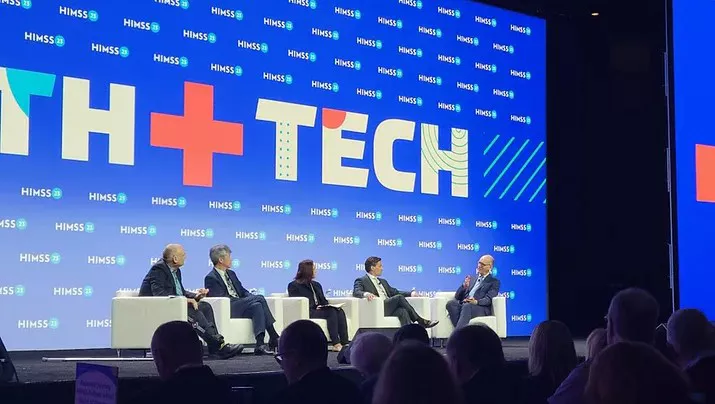Generative AI: What we know and where it could go

Unlocking the possibilities of human creativity and machine processing with generative AI
DALL-E. Midjourney. ChatGPT. Claude. Imagen. Generative artificial intelligence (AI) has begun creeping into public awareness over the past few years, showing up in edgy venues like Art Basel and technocentric publications. However, ChatGPT exploded onto the scene this winter (2022)—and into popular awareness. Hot-take headlines sounded the alarm. Suddenly technology moved from the created to the creator, and the robot overlords of science fiction began to feel a bit more real.
With all the media attention, it can be hard to cut through the hype and decide where to expend our energy in emerging technology like generative AI. What is it that differentiates generative AI from other types of artificial intelligence? What makes it at once deeply terrifying and thrillingly hopeful? What do I need to know about this emerging technology to position myself, my company positively, and my industry for the future?
The world that produced generative AI
Before we can begin exploring potential futures for generative AI, we must first understand the moment in the time surrounding its exponential growth. The COVID-19 pandemic sparked the need to innovate immediately: solve problems from inoculation to workplace communication, from education to socialization. Humans learned anew to value deep connections with one another and with the natural world. At the same time, the realities of climate change began to sink in, underscored by an increase in weather disasters and a growing need for truly sustainable resources. Widespread economic woes and recession fears served to magnify underlying societal disruptions. In this setting, the power of generative AI technologies began to increase exponentially.
Rather than simply using artificial intelligence to perform discrete tasks as designated by a human, generative AI takes human direction and creates. It generates. It interacts. Some tools, like the current headline-darling ChatGPT, produce text. Others create images, videos, code, 3D renderings, or music. By now, the uses of generative AI are limited only by the user’s own imagination. The output quality is likewise limited—by the user’s skill and thoughtfulness.
 A generative AI demo in Slalom’s Element lab212.
A generative AI demo in Slalom’s Element lab212.
Client interactions with generative AI
At Slalom Element lab212 in New York City, we’ve had the privilege of hosting hundreds of clients over the course of the past year. Throughout the tour, we invite clients to immerse themselves in curated scenes where they can experience current and potential realities enhanced through emerging technologies. In one section, visitors interact with a series of natural language generation, natural language processing, synthetic media generation, and digital human tools. We’ve noticed a pattern in which clients react to these emerging technologies.
Awareness and understanding
Most clients who have visited the lab are unaware of the latest advancements in natural language processing or natural language generation as it’s not something they encounter in their day-to-day work or personal life. For many of our visitors, this is the first time they’ve had an opportunity to interact with this technology and see what it is capable of doing. We start with simple demonstrations, prompting the AI to write basic emails or answer simple questions. We then go a little deeper into using a tool like this to pull structured data out of text or merge this text with external data sources. Throughout the experience, awareness builds, and a deeper understanding begins to dawn.
Implications of generative AI
Almost immediately, our visitors start to wonder how this technology will influence their personal and professional lives and the future of industries. They want to know the implications.
Personal
Most of us have had the daunting experience of staring down a blank page with a blank mind. Whether in a business or personal setting, it’s tempting to procrastinate and avoid sitting down to write for as long as possible. As clients witness OpenAI write a thank-you note or generate a marketing tagline, they can imagine using such a tool to kick-start their creative processes: almost like a personalized template. They can then refine and add their own personal touches to the text after the AI has given them a head start.
Professional
The revelation that this technology already exists and is available to anyone today brings up scary discussions of job security. Visitors want to know when or how these types of technologies might be able to replicate the work that they are currently doing. As of today, this technology is not coming for anybody’s jobs, nor do we think it should in the future. We find it much more meaningful to explore how tools like natural language generation can augment the capabilities of humans in the workforce, enrich our personal lives, and bring the best of human creativity and machine processing power together.
Industry
To that end, we frequently demonstrate how clients can use generative AI in their industries. For example, we might show retail clients how they can generate highly personalized follow-up emails to their customers: Begin by using natural language processing to generate the bulk of the text and then marry it with existing customer data. A human sales associate may enter the loop at this point to ensure a more meaningful customer interaction.
Targeted scenarios, augmented by the expertise and human touch of our lab team and internal Slalom partners, allow clients to access emerging technologies in tangible ways. This exploration often sparks inspiration to start experimenting and incorporating this thinking into their larger design plans as they prepare for the future.
 Midjourney-generated art. (Prompt: Modern-day Luddite destroying computers in the style of Picasso)
Midjourney-generated art. (Prompt: Modern-day Luddite destroying computers in the style of Picasso)
On the horizon
Are you a modern-day Luddite?
According to labor economists, automation decomposes skilled labor into easy tasks, weakening workers’ bargaining positions by making it easier for employers to replace them. As technology advances, parts of and whole jobs are increasingly automated or commoditized. This shift and diffusion of skills has continued since the beginning of the Industrial Revolution. Putting pressure on us to continuously learn and move to novel positions of bargaining power in an exponentially competitive world. The premium of valuable work is with those that can adapt the quickest.
Human work advocates may call for a more cautious approach to integrating AI, suggesting that the technology should be developed and deployed to prioritize people’s needs and well-being over corporate profits and efficiency.
Can we stop betting on scarcity?
There is no question that leveling the playing field can increase innovation. When barriers to entry are lowered, more people can participate in creating and developing new ideas. This can lead to a greater diversity of perspectives and a wider range of solutions to problems. Additionally, leveling the playing field can allow for more experimentation and risk-taking, as people feel less constrained by traditional structures and expectations. This can create an environment more conducive to innovation, creativity, and progress.
Anyone can create new products, services, and experiences with generative AI. This technology democratizes innovation, making it possible for anyone, anywhere, to be a creator. And when more people create, we see more competition, leading to healthier markets and more consumer choices.
What the heck is “human” work?
The answer lies in human strengths that machines cannot replicate. Creativity, empathy, and critical thinking are still very much needed in the future workforce. And while some jobs may disappear, others will be created in their place. For example, we will need people to design and oversee algorithms and those who can manage and interpret data. We will also need more people to care for an aging population and provide emotional support to those struggling with mental health issues.
We will need to constantly develop new ideas and approaches to solve problems. Our ability to think creatively and adapt to change will be the key to success. Our work will also require us to be more collaborative, as we will need to share ideas and solve problems together. Luckily, all these new expressions of work allow for self-actualization and satisfaction in our work that is aligned with fulfilling our purpose over the exploitative nature of corporate productivity today.
 Midjourney-generated art. (Prompt: a computer from the future in the style of Picasso)
Midjourney-generated art. (Prompt: a computer from the future in the style of Picasso)
Now what?
While information has its own value, we’d also like to leave you with some concrete steps to begin exploring generative AI and incorporating it into your work, life, and future.
Next best action
Try one out for yourself. There are many to choose from, and they cover a variety of tasks and domains. Most come with trial periods or free betas. Now is the time: go experiment!
If, then, else
If: Consider use cases in your personal and professional workflows.
Then: How might you modify your research, creative, or engineering workflows to include these tools as a step in the process? Would the efficiency gained allow you to push boundaries or spark creative innovation?
Else: How else would you use the results from generative AI inquiries? How might they be used in collaborative settings? For example, Slalom is working with our customers to use generative AI in live innovation workshops to explore the future and tell stories of the possible.
Check your bias
What are the fears you have about this technology? Robots taking over, loss of jobs, dumbing down of the population—all fair game. What information are you consuming? What are the objective facts, and what confirms your beliefs (or fuels your fears)?
Don’t let your first impressions keep you from using technology to build better tomorrows for all.
This blog post was originally published here.



